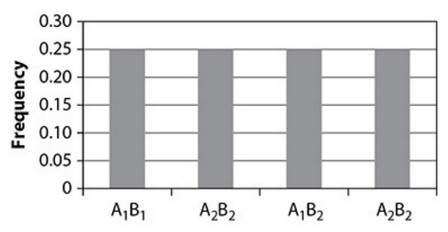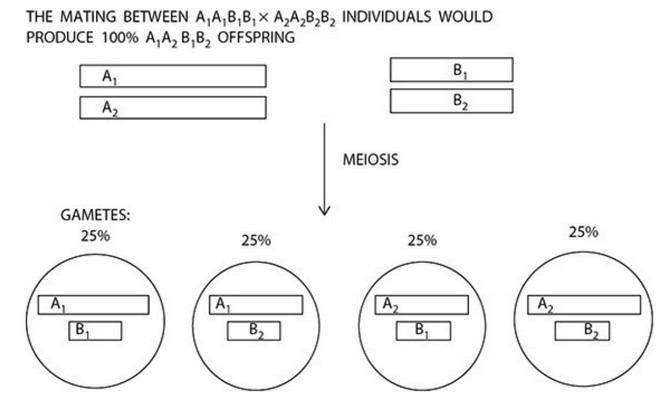Question
Which of the following is a characteristic of a population that is in Hardy-Weinberg equilibrium?
(A) small population size
(B) gene flow
(C) sexual selection
(D) no mutations
▶️Answer/Explanation
Ans:
(D) The five conditions that are necessary for Hardy-Weinberg
equilibrium are large population size, random mating, no selection of
any kind, no gene flow, and no mutations. Choice (A) is incorrect
because large populations, not small populations, are necessary for
Hardy-Weinberg equilibrium. Migration (or gene flow) also violates
one of the conditions necessary for Hardy-Weinberg equilibrium, so
choice (B) is incorrect. Choice (C) is incorrect because in order for a
population to be in Hardy-Weinberg equilibrium, no selection can
occur.
Question
Ebony body color is an autosomal recessive trait in fruit flies. In a large, randomly mating population of fruit flies that is in Hardy- Weinberg equilibrium, the frequency of ebony body color is 21%. What is the percentage of the population with the homozygous dominant genotype?
(A) 29%
(B) 45%
(C) 54%
(D) 79%
▶️Answer/Explanation
Ans:
(A) If 21% of the population has the recessive phenotype, \(q^2 = 0.21\) and q = 0.458. Since p + q = 1, p = 1 – 0.458 = 0.542. The frequency of
homozygous dominant individuals is \(p^2= (0.542)^2 = 0.29\), or 29%.
Choice (B) is the frequency of the recessive allele and is incorrect.
Choice (C) is incorrect because 54% is the frequency of the dominant
allele, not the homozygous dominant genotype. The frequency of the
dominant phenotype is 79%, so choice (D) is also incorrect.
Question
For a genetic disease that appears in homozygous recessive (aa) individuals, individuals who are heterozygous (Aa) for the disease are resistant to infections by certain parasites. If 19% of the individuals in a population have the genetic disease, what is the frequency of individuals who are resistant to the parasites?
Assume the population is in Hardy-Weinberg equilibrium.
(A) 0.436
(B) 0.492
(C) 0.564
(D) 0.810
▶️Answer/Explanation
Ans:
(B) If 19% of the individuals have the recessive genetic disease, q
2
=
0.19 and q = 0.436. Then since p + q = 1, p = 0.564. The heterozygous
individuals are resistant to the parasites and have a frequency of 2pq =
2 × 0.564 × 0.436 = 0.492. Choice (A) is the frequency of the recessive
allele and is incorrect. Choice (C) is the frequency of the dominant
allele and is incorrect. The frequency of individuals who do not have
the recessive disease (some of whom may be heterozygous and others
who may be homozygous dominant) is 81%, so choice (D) is incorrect.
Question
Refer to the following figure and data.


Perissodus microlepis is a scale-eating fish whose population is under frequency-dependent selection. The frequency of right- and left-mouthed individuals oscillates over time but balancing selection (due to frequency dependence) keeps the frequency of each phenotype to approximately 50%. The trait is determined by two alleles by simple Mendelian inheritance. Open circles indicate the frequency of left-mouthed individuals among adults that reproduced in the 3 years that data was collected.
Calculate the change in frequency of left-mouthed individuals between 1985 and 1988.
(A) 15%
(B) 40%
(C) 50%
(D) 60%
▶️Answer/Explanation
Ans: A
The frequency of left-mouthed individuals in 1988 is greater than
0.4 but less than 0.5. The frequency of left-mouthed individuals in 1985 is
0.6, so the difference is between
0.4 – 0.6 = –0.2 (–20%)
and
0.5 – 0.6 = –0.1 (–10%).
This effect is known as frequency-dependent selection, a phenomenon
in which the fitness of a phenotype depends on how common it is in a
population. In this example, a left-mouthed fish always attacks on the right
side of the fish it’s feeding on. The prey fish become more adept to
defending against attack from the most common phenotype of scale-eater in
the lake. If most of the attacks come from the right, they guard attacks from
the right. The result is that selection works against the phenotype that is
most common (or favors the phenotype that is least common). This
oscillation in selective pressure between two phenotypes based on their
frequencies results in a balancing selection that keeps each frequency close
to 50%.
Question
Refer to the following graphs, each of which shows the genotype frequencies of the gametes of the \(F_1\) generation that resulted from the random mating between the two parent populations, one with the genotype \(A_1A_1B_1B_1\) (only) and the other with genotype \(A_2A_2B_2B_2\) (only). The two loci, A and B, each have two alleles, 1 and 2.

Which of the following statements is true if the mating between the two populations produced offspring with the gametic frequencies shown above?
(A) Genes A and B must be on different chromosomes.
(B) Independent assortment is not acting during this time.
(C) The alleles for genes A and B segregate randomly during meiosis.
(D) The traits for genes A and B were not acted upon by natural
selection in the production of this generation.
▶️Answer/Explanation
Ans: C
The x-axis shows the possible allelic combinations in the
gametes. There is no indication that allele 1 or 2 for either gene is dominant
or recessive. It doesn’t matter—the question is whether or not the alleles
assort independently. There are four possible combinations of gametes,
each of which appear with equal frequency, so it can be assumed that the
genes for A and B are on different chromosomes, or that they are located far
enough apart on the same chromosome to be separated by crossing over
during meiosis about 50% of the time (they appear to assort independently).
(See the following figure on independent assortment and answer 31 to
contrast with gene linkage.)

